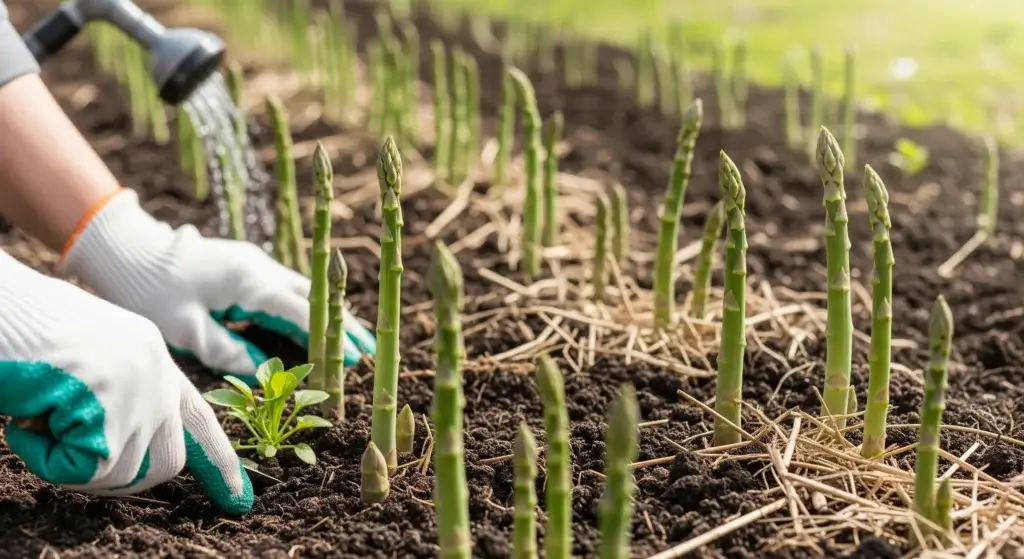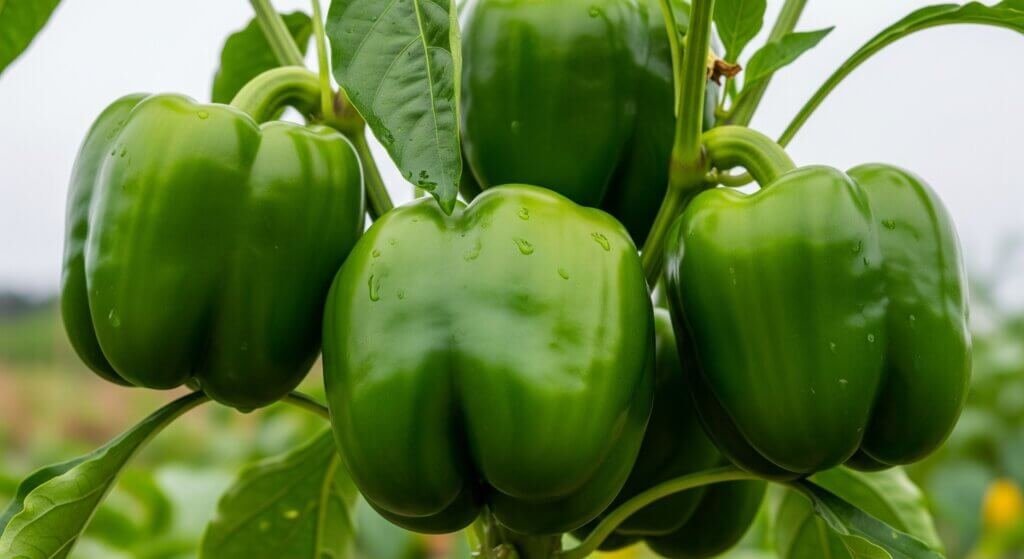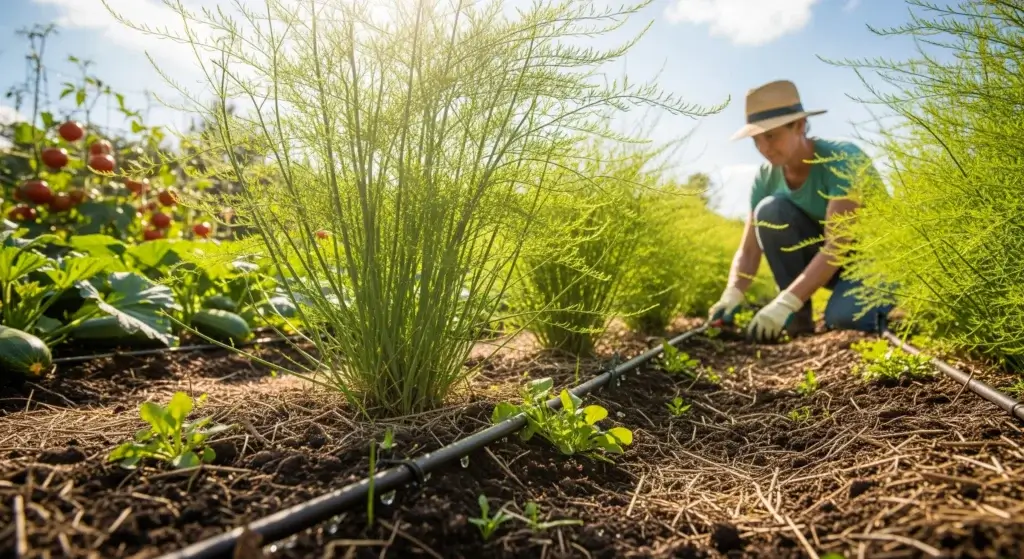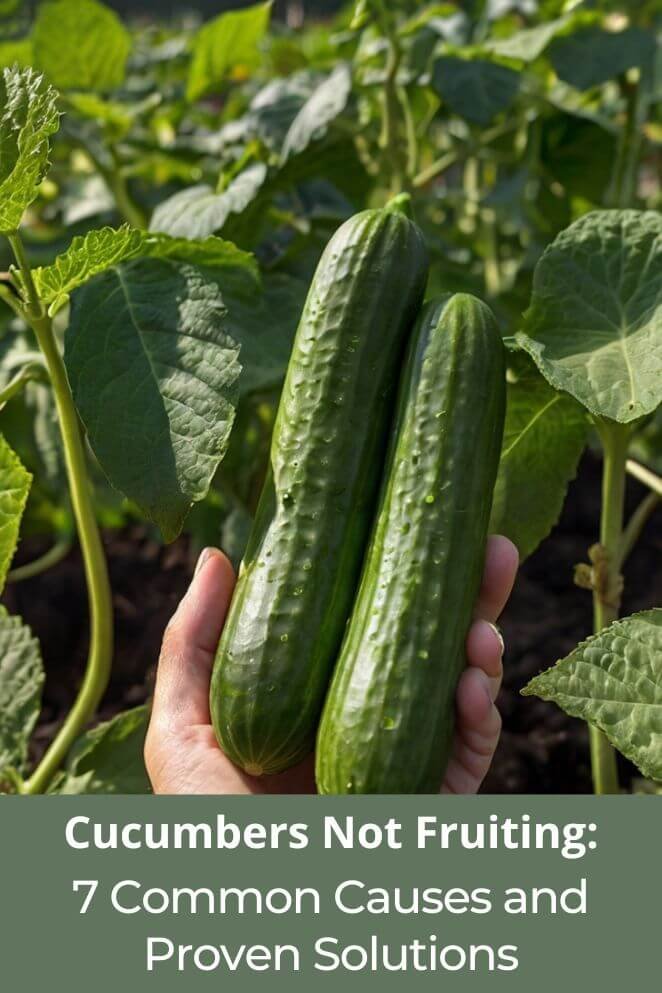
Got loads of cucumber flowers but no actual cucumbers? You’re not the only one.
It’s like your plants are throwing a party and forgot to invite the fruit.
This guide breaks down why your cucumber vines are all show and no grow—and gives you simple, no-nonsense fixes to turn those diva blooms into real veggies.
Think of it as your “cuke intervention,” minus the drama and with fewer plot twists than a telenovela.
7 Common Causes Your Cucumbers Not Fruiting
Let’s break down why your cucumber plants are all flowers and no cucumbers—and how to fix it without losing your mind (or your summer salad dreams).
1. Insufficient female flowers
At first, your cucumber plant grows mostly male flowers.
These guys show up early, look great, and do absolutely nothing for fruit.
No females = no cukes.
Fix it:
- Don’t panic—females usually show up a week or so later.
- Female flowers have a mini cucumber behind them (super easy to spot once you know).
- Want more fruit? Plant gynoecious varieties (they’re mostly female), but add a few monoecious types to get the pollen party going.
- Bonus tip: Keep a little garden journal—note when the guys and gals appear. It’s like Tinder analytics, but for cucumbers.
2. Poor pollination
Even with both flower types, no fruit happens if there’s no pollination.
Bees are usually the matchmakers, but they ghost sometimes (thanks, pesticides and bad weather).
Fix it:
- Play bee: Use a paintbrush or swap pollen with a male flower directly. Mornings are best—think of it as plant speed dating before it gets too hot.
- Plant flowers nearby like marigolds and sunflowers. It’s like creating a VIP lounge for pollinators.
- Cut the pesticides. Your bugs can’t pollinate if they’re, well, dead.
- Add bee-friendly stuff—shallow water dishes, logs, or bare soil. Basically, roll out the red carpet for the pollinators.
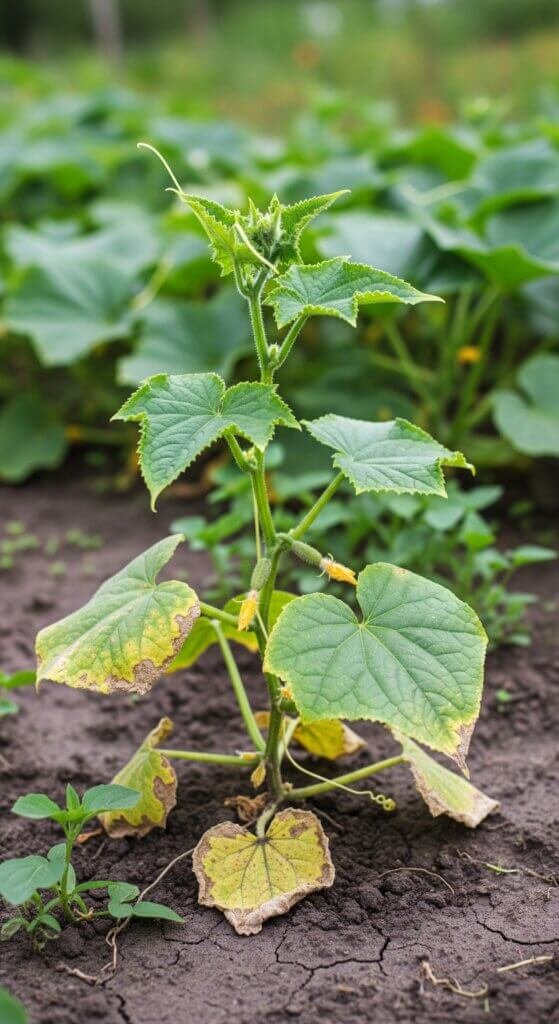
3. Temperature stress
When temps spike, cucumbers get stressed. Like cancel-all-plans-and-sit-in-the-shade stressed.
Flowers drop, fruit stalls, vibes crash.
Fix it:
- Throw some shade—literally. Use 30–50% shade cloth during heat waves.
- Let the air flow. Space your plants and use fans in greenhouses.
- Mulch like a pro (3–4 inches). Keeps roots cool and happy.
- Water more often—but don’t drown them. Think spa, not flood.
- Grow heat-tolerant varieties if your summers feel like you live on the sun.
4. Nutrient imbalances
Too much nitrogen = giant leafy vines, zero cucumbers.
It’s like a bodybuilder who skips leg day—impressive foliage, no substance.
On the flip side, lack of key nutrients can block fruiting altogether.
Fix it:
- Ease up on nitrogen. Switch to something more balanced or low-N.
- Boost phosphorus (look for fertilizers where the middle number is higher—like 5-10-10). That tells the plant: “Time to flower, not flex.”
- Keep boron in check. Your cukes are picky—too little or too much and they throw tantrums.
- Test your soil yearly to see what’s really going on underground.
Feeding cheat sheet:
- Before planting: Add compost or well-aged manure
- Early growth: Go with a balanced mix (10-10-10)
- Flower time: Switch to a phosphorus-rich blend (5-10-10)
- Fruit time: Stick with that phosphorus boost
5. Watering issues
Cucumbers are divas when it comes to water.
Drown them and they sulk.
Forget to water? Same result. Inconsistent watering confuses the plant—and it decides to ghost the fruiting process.
Fix it:
- Keep the soil evenly moist, like a wrung-out sponge—not mud, not desert.
- Water deep, 2–3 times a week. Skip the daily sprinkle—it’s like giving your plant a sip when it needs a chug.
- Mulch is your cucumber’s emotional support blanket. It keeps moisture in and roots chill.
- Use drip irrigation if you’re fancy (or just tired of dragging a hose).
- Do the finger test: stick your finger 2–3 inches into the soil. Dry? Water. Moist? Chill.
6. Environmental stress factors
Cucumbers are basically drama queens about the weather.
One strong wind or surprise cold snap, and boom—flower drop.
Low light? Forget fruit.
Fix it:
- Shield them from strong wind with barriers or plant near fences.
- Give them 6–8 hours of full sun daily. Cucumbers are sun worshippers—shade is not their vibe.
- Don’t just toss seedlings outside. Harden them off—gradually introduce them to the wild like a baby sea turtle learning to swim.
- Space them out. Good airflow = fewer diseases and better light access = happier vines = actual cucumbers.
7. Pest and disease management
Bugs like cucumber beetles and aphids, plus fungal freeloaders, can mess up your whole fruiting situation.
They suck juices, spread diseases, and basically treat your plant like a buffet.
Fix it:
- Inspect weekly—lift leaves, check stems, play detective.
- Attract the good bugs (ladybugs, lacewings) that eat the bad bugs. It’s like nature’s version of “Avengers: Garden Edition.”
- Go organic: neem oil, insecticidal soap, and diatomaceous earth work wonders without killing off your helpful allies.
- Rotate your crops every season—don’t let the pests know your address.
- Clean up fallen leaves and sick-looking vines ASAP—don’t let pests set up camp.
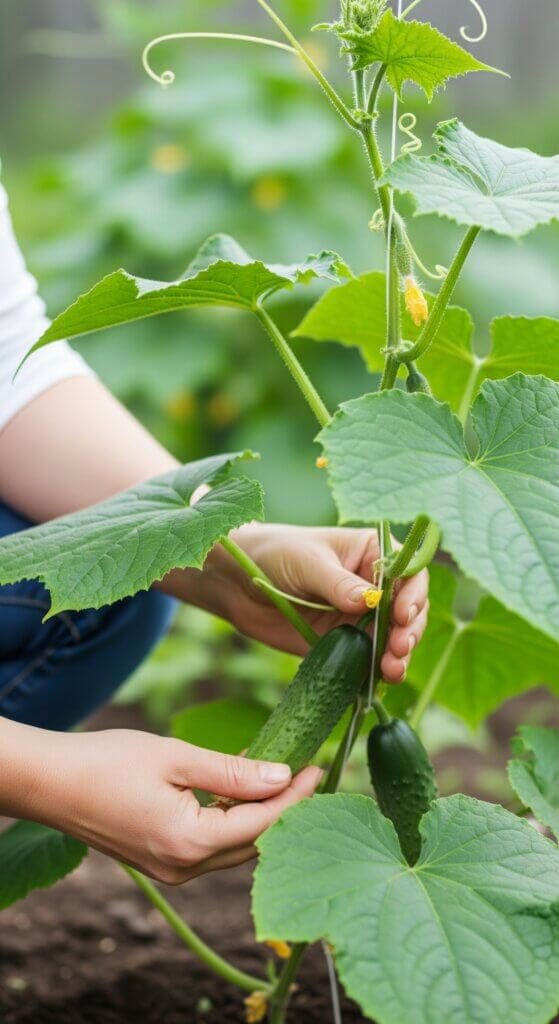
Creating the Ideal Growing Environment
Let’s set the stage so your cukes don’t just survive—they thrive like they’re on a five-star garden retreat.
Soil preparation
Cucumbers are picky roommates.
They want soil that drains well, but also has enough organic goodness to keep them fed.
- Keep pH in the 6.0–7.0 range—neutral vibes only.
- Add compost or aged manure like you’re prepping a Michelin-star meal.
- Give them space—12 to 18 inches apart—nobody likes a clingy neighbor.
Companion planting
Cucumbers aren’t total loners, but they’re selective.
- Radishes, peas, beans, marigolds = cool squad. They help with pest control, pollination, and good vibes.
- Sage and mint? Hard pass. They smell nice but can mess with the pollinators your cukes rely on. It’s like bringing drama to a peaceful brunch.
Season extension
Don’t let a little cold or short season cramp your cucumber dreams.
- Use row covers early on—it’s like giving your plants a cozy jacket until the weather levels up.
- Go vertical with trellises or cages—great for airflow, easy harvests, and honestly, a lot less bending.
- Try succession planting (aka staggered sowing) so you’re not stuck with a single cucumber dump all at once. Spread the harvest love.
Troubleshooting Checklist for Non-Fruiting Cucumbers
If your cucumber vines are all leaves and no love (a.k.a. fruit), don’t panic.
Run through this checklist like a garden detective. It’s CSI: Veggie Edition.
- Flower assessment
- Got both male and female flowers? Or is it a bachelor party in there?
- Are your females hiding out? (They’ve got a mini cucumber behind the bloom. Super easy to spot once you know.)
- Are the flowers looking fresh, open, and ready to mingle—or shriveled like last week’s salad?
- Pollination check
- See any pollinators buzzing around, or is it radio silence?
- Tried a little DIY pollen matchmaking with a brush or flower-to-flower swipe? It’s not weird, it’s effective.
- Spraying pesticides while they’re flowering? Yeah… bees hate that. Ease off during bloom time.
- Environmental evaluation
- Temps in the 65–75°F sweet spot? Too hot or too cold = cucumber drama.
- Are your plants getting at least 6 hours of sun a day? Cucumbers are sun-chasers.
- Is your watering on point? Consistent, deep watering is key. No mood swings here.
- Nutrition review
- When did you last feed them? (No judgment if you forgot.)
- What kind of fertilizer are you using? Too much nitrogen = all leaves, no fruit.
- Seeing weird leaves or stunted growth? Could be a nutrient issue. Time for a little soil reality check.
- Stress factors
- Bugs or funky spots on the leaves? Aphids and beetles love a good cucumber buffet.
- Did you plant them straight outside with zero prep? That’s called transplant shock—happens to the best of us.
- Any sudden weather shifts, wind attacks, or overcrowding? All stress = less fruit.
Prevention Strategies for Future Success
Want your cucumbers to crush it next time? Here’s how to set them up for long-term success—no stress, no ghosting, just juicy results.
Variety selection
Not all cucumbers are built for your backyard.
- Choose varieties that match your local climate and growing style—don’t plant a diva in a desert if she needs A/C.
- Look for disease-resistant types to dodge the usual cucumber villains.
- Bonus: Some varieties are bred specifically for heat, humidity, or short seasons—use that to your advantage like a pro casting director.
Timing considerations
- Don’t plant cukes when the soil’s still chilly—they hate cold feet. Wait until it’s 60°F or warmer.
- In colder areas, start seeds indoors and move them out after the last frost. Think of it as cucumber pre-gaming before the outdoor season kicks off.
- Too early = stress. Too late = rushed. Aim for the Goldilocks zone.
Long-term garden health
- Rotate your crops like it’s a dance floor—don’t plant cucumbers in the same spot every year. It keeps pests guessing.
- Feed your soil regularly with compost or aged manure—healthy soil is like a cucumber spa.
- Make your garden a biodiversity party. Plant flowers and herbs that attract the good bugs (think ladybugs, lacewings, bees). A healthy ecosystem means fewer problems and more cucumbers.
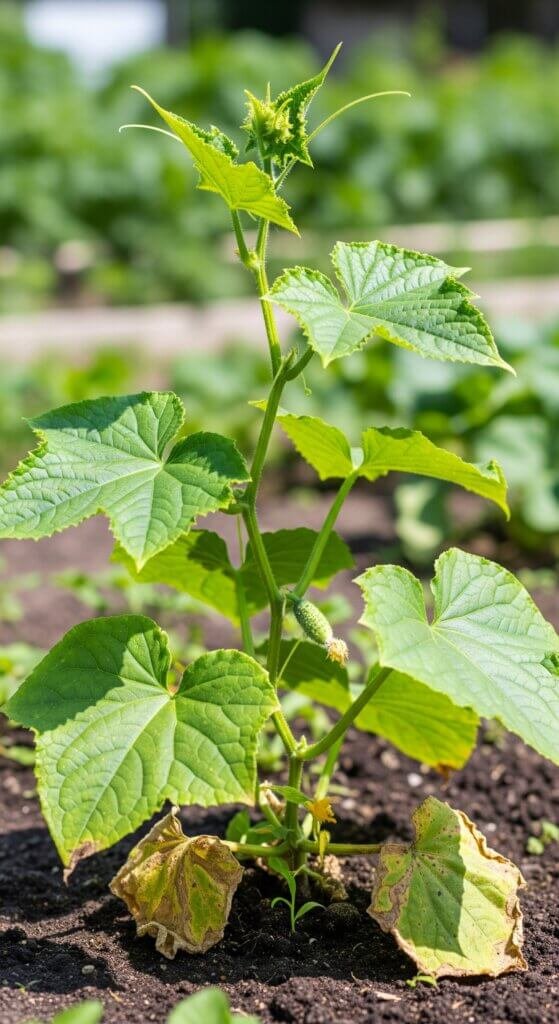
Conclusion: From Barren Vines to Bountiful Harvests
Cucumbers ghosting you? Totally fixable. Most of the time, it’s a mix of flower drama, poor pollination, weather mood swings, or feeding issues.
Get to know what your plants need, keep your care consistent, and be patient when the guys (male flowers) show up first.
Tweak what’s off—hand pollinate if bees are MIA, fix watering or nutrient issues, and create the kind of garden cucumbers want to live in.
It’s like turning a fussy houseplant into a fruit machine.
Give your vines attention (not too clingy though), and they’ll pay you back in crispy, snack-worthy cucumbers all season long.
You’ve got this—now go turn those vines into a cucumber success story.

